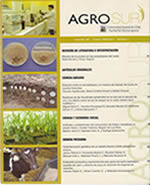Morphostructural characteristics of a goat herd in the Mediterranean area of central Chile
Main Article Content
Abstract
An analysis of the morphometric variables and zoometric index of a herd of creole goats in the Mediterranean area of central Chile was conducted, considering both females and males of three age categories (unweaned kids, growing kids, and adults). These variables were analysed using variance and principal components analysis. In most of the analysed variables, the effect of sex and age and their respective interaction was significant. The principal component analysis allowed to reduce the number of variables to be analysed (from 16 to 8 variables) establishing two major components, one related to the size and the other referring to the animal compactness which explained 70.86% of the data variability. The comparative analysis of the zoometric index allowed to characterise the animals of the studied herd as meat aptitude, mesacephalous (males), brachycephalic (females), mesomorphs, thin cannon bones, with the posterior body zone being less developed than the anterior body zone and great scapular development.

